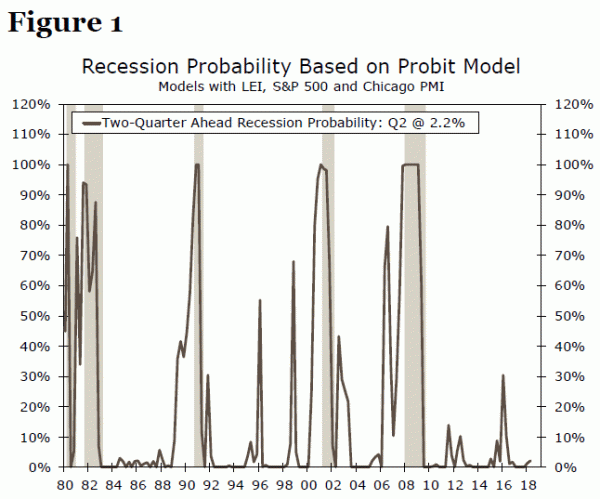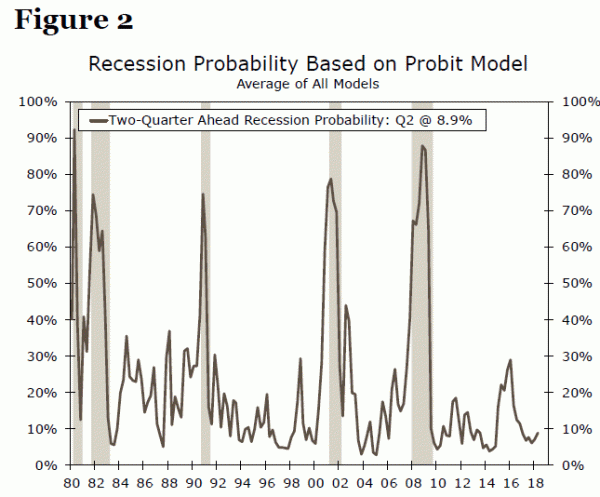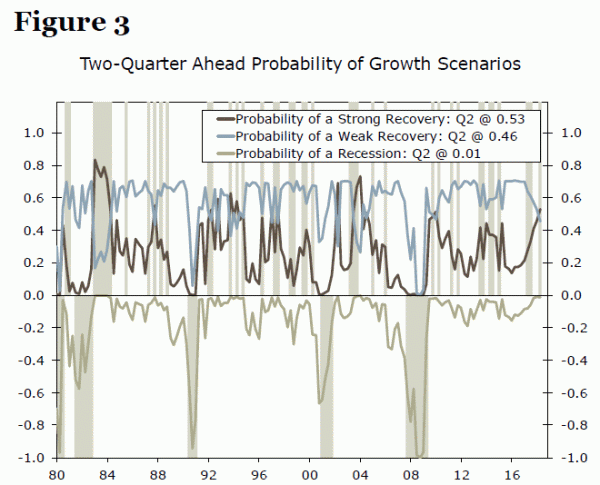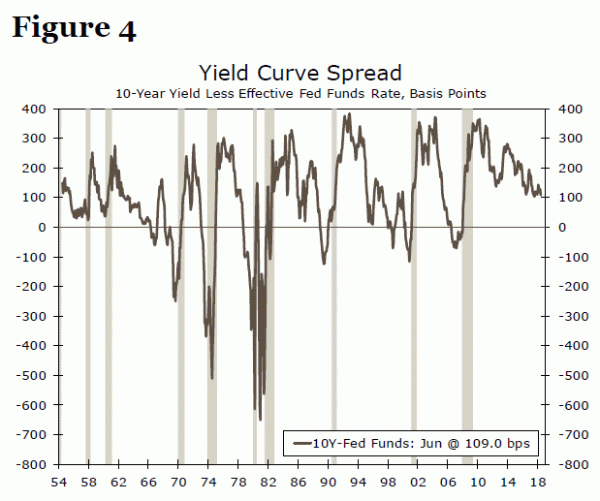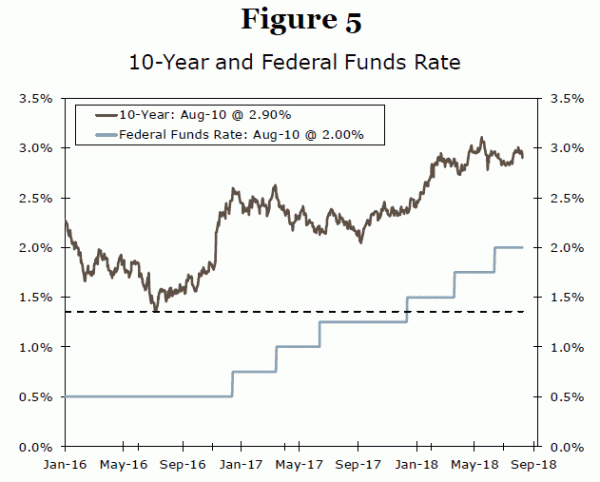“To expect the unexpected shows a thoroughly modern intellect.” – Oscar Wilde
Executive Summary: Bright Sunshine in the Short Run, Clouds Are Gathering Over the Medium Term
So far, 2018 shows interesting (and, to some extent, contradictory) developments. While the economic/financial world experienced some healthy gains, recession worries are also in the picture. That is, Q2-2018 GDP growth came in at 4.1 percent, and the S&P 500 Index hit 2,800 for the first time (in January 2018). The flip side of the coin is that, mainly due to the rising fed funds rate environment, some analysts are worried about the inverted yield curve and the impending risk of a recession. Furthermore, the current expansion is the second-longest expansion on record. It is true that expansions don’t die of old age, but they are not eternal either—and a recession ends an expansion phase.
To inform our readers, we updated our models to estimate the potential risks of a recession in the short run (within the next six months), as well as in the medium term (the next couple of years). Our preferred Probit model suggests a very low probability (less than 5 percent) of a recession during the next six months. The ordered Probit model, which predicts the probability of a recession as well as the strength of a recovery/expansion, also shows a very low recession possibility for the next six months. The model is suggesting above-trend growth for the rest of 2018. Essentially, our models suggest bright sunshine and no recession risk for the rest of 2018.
Last year, we developed a new framework to predict recessions in the medium term (up to two years ahead). The predictive power of the framework is significantly higher than the inverted yield curve; our proposed method predicted all recessions since 1954, but the inverted yield curve failed to predict recessions during the 1954-1965 period.1 Our proposed framework identifies a threshold between the fed funds rate and the 10-year Treasury yield, and when the threshold is breached, the risk of a recession in the medium term is significant. This threshold was breached in December 2017. Historically, when the threshold is met, there is 69.2 percent chance (average probability) of a recession within the next 17 months (average lead time). Therefore, this framework suggests that clouds are gathering over the next couple of years.
In addition, there are two major recent developments that can affect the threshold’s call. First, there is the 2018 tax cuts to consider, but we believe the net effect of the tax cuts may be neutral (and may not affect the threshold call). On the one hand, the tax cuts are likely to boost personal spending and after-tax corporate profits (at least in the short run). On the other hand, the tax cuts may put the FOMC on a faster rate-hike track, as there is a high probability of four rate hikes in 2018. The four rate hikes may take the fed funds rate close to its peak of the cycle. Historically, the peaking of the fed funds rate in a monetary cycle has been an indication of an elevated risk of a recession in the medium term.2
The second factor is the newly-announced and enacted tariffs (and fears of a trade war), which may favor the threshold’s call by creating challenges for business as well as for consumers, at least in the near term.3 At present, we are not making a recession call for 2019, and are instead forecasting healthy growth (2.9 percent for 2019). We will be evaluating the upcoming data and will publish a report if we notice significant developments, either against or in favor of the threshold’s call. Therefore, we suggest that decision makers carefully monitor the upcoming data in the rest of 2018 and 2019 to gauge signs of a turning point.
Forecasting Recession Risks for the Short Run: No Worries!
One useful method of predicting the chances of a recession over the near term is to build a Probit model. A Probit model, in the present case, estimates (using a handful of predictors) the probability of a recession for a certain period in the future. Our official model, which we built back in 2007, utilizes the Leading Economic Index (LEI), S&P 500 Index and Chicago PMI employment index as predictors. Our model has served us well, as it started predicting (in real-time) a significantly higher probability of recession in 2007 (58 percent probability in Q3-2007).4 In addition, we never joined the “double-dip” camp back in 2010-2012, largely because our Probit model never indicated that a recession during that time period was likely.
Using the most recent data, our model suggests a less than 5 percent probability of a recession during the next six months (Figure 1). The reason for the low recession probability in 2018 is that the LEI, the key predictor in our model, has not shown a single month of negative growth so far this year. A decline in the LEI may indicate weakness in the economy. Furthermore, given the positive momentum of the LEI (the average growth rate is 0.42 percent in 2018), it would be very difficult to imagine a recession in 2018.
Back in 2016, in addition to our official Probit model, we built seven sector-specific Probit models to capture the risk of a recession for the U.S. economy.5 The different models utilize information from different sectors of the economy to estimate the potential risk posed by those sectors. We take the average probability from all these models to estimate the potential risk of a recession posed by the major sectors of the economy. Currently, the average probability is very low (8.9 percent, Figure 2).
To sum up, our Probit models are suggesting a very low risk of a recession for the rest of 2018. There is always possibility of a shock, but economic fundamentals are strong at present.
Predicting Growth Outlook for the Near Term: Above Trend Growth
Economies evolve over time, as do the relationships between economic/financial variables. For example, the Great Recession ended in June 2009, but the first interest rate hike by the FOMC occurred in December 2015. One major reason for the accommodative monetary policy stance (even after the recession ended) was the painfully slow nature of the recovery when compared to historical standards. Therefore, it is important to predict the pace of a recovery/expansion (weaker versus stronger) in addition to the timing of a recession. A weaker recovery prediction (such as the recovery from the Great Recession) suggests a continuation of accommodative monetary policy, as opposed to a stronger recovery forecast, which may support a change in the monetary policy stance.
Therefore, we built an ordered Probit framework that simultaneously predicts the probability of a recession and the strength of a recovery/expansion. The model’s estimates are very impressive; the model successfully predicted all recessions and the pace of recoveries since the 1980s in a simulated, out-of-sample experiment.6 The most recent estimate of the model (based on Q2-2018 data) suggests higher chances (53 percent probability) of above-trend growth (around 3.0 percent to 3.5 percent) for the second half of 2018 (Figure 3).
In sum, the growth outlook for the rest of 2018 looks to be above-trend (our official forecast is 3.1 percent for 2018). The current expansion is the second-longest expansion on record and, typically, economies produce slower growth rates in late phases of the business cycle, as resource utilization is either at or close to its peak. We expect economic growth to lose some steam, as we are predicting 2.9 percent growth for 2019.
Yes, We are All Dead in the Long Run. What About the Medium Term?
Keynes once said that in the long run we are all dead. We agree with Keynes, but the medium-term economic outlook is also important for decision makers. This is because a different set of decisions is required when anticipating a recession compared to when the medium-term outlook is bright. Therefore, to estimate the medium-term recession risk (up to a couple of years), we developed a new framework last year. Our proposed framework identifies a threshold between the fed funds rate and the 10-year Treasury yield (we call it the FFR/10-year threshold). In a rising fed funds rate environment, the threshold is breached when the fed funds rate touches/crosses the lowest level of the 10-year Treasury yield in that cycle. When this occurs, the risk of a recession in the near future is significant.
Our framework has successfully predicted all recessions since 1954, with an average lead time of 17 months. Furthermore, our framework predicted several recessions before the yield curve inversion point/monetary cycles approach and, therefore, serves as a more effective tool in predicting recessions. That is, with our framework, we do not have to wait for the yield curve to invert to predict a recession (Figure 4).
Why is our analysis important for decision makers? In the current monetary cycle, the lowest 10-year Treasury yield was 1.36 percent (hit on July 5, 2016) and the current fed funds rate is 2.00 percent (as of August 2018). Furthermore, the fed funds rate, for the first time in the current monetary cycle, hit 1.50 percent in December 2017 (with the December 2017 rate hike by the FOMC), and thereby crossed the lowest level of the 10-year Treasury (1.36 percent) and breached the FFR/10-year threshold (Figure 5). Historically, when the threshold is met, there is 69.2 percent chance (average probability) of a recession within the next 17 months (average lead time). Therefore, the risk of a recession during the next couple of years is elevated and decision makers should be watching the upcoming data for potential signs of a turning point.
Can the 2018 Tax Cuts and Tariff Announcements Affect the Threshold’s Call?
With the FFR/10-year threshold conditions met in December 2017, and with an average lead time of 17 months between a breach of the threshold and a recession, it seems that clouds are gathering over the next couple of years. Are there any major factors which could either clear the clouds or bring in a storm? In this ever-changing world, many factors could affect the threshold call. Here, we review two major developments which have occurred in 2018.
The first major factor is the 2018 tax cuts. We believe the tax cuts would have a dual effect on the recession call. (A) The tax cuts lift after-tax personal income and that is likely to boost personal spending, at least in the short run. Similarly, corporations would enjoy higher after-tax profits. Therefore, the tax cuts may “push” a recession further into the future.
(B) On the other hand, the tax cuts could affect the pace of monetary policy (in our view, they already have) by putting the FOMC on a track of faster rates hikes. The FOMC has raised rates twice in 2018, with a very high possibility of two more interest rate hikes (total of four rates hikes in 2018), in addition to rolling back the Fed’s balance sheet. However, the FOMC raised rates only once in 2016 and three times in 2017. The major reason for the FOMC’s faster pace of rate hikes is that the FOMC may be uneasy about “over-heating” and/or inflationary pressure due to the 2018 tax cuts. The faster pace of rate hikes is putting upward pressure on borrowing costs, as interest rates are an important element of borrowing costs. Furthermore, with two more rates hikes, the fed funds rate will be at 2.50 by the end of 2018, and some analysts are suggesting the terminal (or equilibrium) fed funds rate is in the 2.00-3.00 percent range.7 That is, with two more rate hikes, the fed funds rate would be close to its peak. The peaking of the fed funds rate is another indication of an upcoming recession.8 Given the counteracting effects of (A) and (B), the cumulative effect of the tax cut on the framework’s recession call is neutral.
The other major economic event of 2018 is the announcement and subsequent enactment of new tariffs, which have boosted fears of a global trade war. The U.S. has implemented tariffs on several countries’ products, and most of those countries have announced/applied retaliatory tariffs on U.S. products. The potential effect of these tariffs (in addition to the global trade war fear) is a disruption of global supply chains, which has the potential to affect the overall U.S. economy. In other words, trade tensions may favor the threshold call.
In summary, our approach to predict the medium-term risk of a recession suggests an elevated chance of a recession in the next the couple of years. The 2018 tax cuts may not affect that call because of the dual effect of the tax cuts. The tariffs, by creating a fear of a trade war and by potentially disrupting global supply chains, may support the threshold’s call. However, at present, U.S. economic fundamentals are very strong and our official call for 2019 is 2.9 percent GDP growth. We will be evaluating upcoming data to gauge signs of a turning point in the next couple of years. Therefore, we suggest decision makers carefully monitor the upcoming data in the rest of 2018 and 2019 to examine whether the “sky” is getting clearer or clouds are forming.
Concluding Remarks: No Worries for the Short Run, Be Cautious for the Medium Term
Our models are suggesting very low recession risks for the rest of 2018. In addition, the ordered Probit model is predicting above-trend growth for the next couple of quarters. Essentially, both approaches are suggesting that fundamentals are strong, at least in the near term. Our official call for 2019 is a healthy economy with 2.9 percent growth.
However, our medium-term model is suggesting a cautious outlook for the next couple of years. Potential challenges to the medium-term outlook include rising interest rates, which may push up borrowing costs for investors/consumers. The peaking of the fed funds rate, which is associated with recessions, is another risk. Furthermore, trade tensions are also creating challenges by boosting fears of a trade war. We will be evaluating the upcoming data and will publish a report if we notice significant developments either against or in favor of the threshold’s call. Decision makers should also carefully monitor the upcoming data in the rest of 2018 and 2019 to gauge signs of changes in the momentum of the economy.
1 For more detail about the new methodology, see “Do We Need to Wait for a Yield Curve Inversion to Predict a Recession? No.” (September 8, 2017). Available upon request.
2 Adrian, T and Estrella, A. (2009). Monetary Tightening Cycles and the Predictability of Economic Activity. NY FRB Staff Reports, No 397, October 2009.
3 “How Costly Would a Full-Blown Trade War Be?” (April 5, 2018). Available upon request.
4 For a detail discussion about Probit models, see our report “Recession Talks in the Spotlight: Should We Worry?” (February 24, 2016). Available upon request.
5 Ibid.
6 “Predicting the Probability of Recession and Strength of Recovery: An Ordered Probit Approach” (July 19, 2016). Available upon request.
7 Bullard, B. James. (2018). R-Star war: The Phantom Menace. Business Economics, Vol 53.
8 Adrian, T and Estrella, A. (2009). Monetary Tightening Cycles and the Predictability of Economic Activity. NY FRB Staff Reports, No 397, October 2009.




